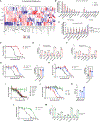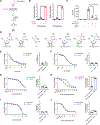Macrophage-Released Pyrimidines Inhibit Gemcitabine Therapy in Pancreatic Cancer
- PMID: 30827862
- PMCID: PMC6602533
- DOI: 10.1016/j.cmet.2019.02.001
Macrophage-Released Pyrimidines Inhibit Gemcitabine Therapy in Pancreatic Cancer
Abstract
Pancreatic ductal adenocarcinoma (PDA) is characterized by abundant infiltration of tumor-associated macrophages (TAMs). TAMs have been reported to drive resistance to gemcitabine, a frontline chemotherapy in PDA, though the mechanism of this resistance remains unclear. Profiling metabolite exchange, we demonstrate that macrophages programmed by PDA cells release a spectrum of pyrimidine species. These include deoxycytidine, which inhibits gemcitabine through molecular competition at the level of drug uptake and metabolism. Accordingly, genetic or pharmacological depletion of TAMs in murine models of PDA sensitizes these tumors to gemcitabine. Consistent with this, patients with low macrophage burden demonstrate superior response to gemcitabine treatment. Together, these findings provide insights into the role of macrophages in pancreatic cancer therapy and have potential to inform the design of future treatments. Additionally, we report that pyrimidine release is a general function of alternatively activated macrophage cells, suggesting an unknown physiological role of pyrimidine exchange by immune cells.
Keywords: deoxycytidine; gemcitabine resistance; immunometabolism; macrophage; metabolic crosstalk; metabolomics; pancreatic cancer; pancreatic ductal adenocarcinoma; tumor microenvironment; tumor-associated macrophage.
Copyright © 2019 Elsevier Inc. All rights reserved.
Figures




Comment in
-
Macrophages throw tumour cells a lifeline.Nat Rev Immunol. 2019 Apr;19(4):202-203. doi: 10.1038/s41577-019-0148-1. Nat Rev Immunol. 2019. PMID: 30837672 No abstract available.
-
Metabolite crosstalk could modulate chemotherapy response in pancreatic cancer.Nat Rev Gastroenterol Hepatol. 2019 May;16(5):262. doi: 10.1038/s41575-019-0143-9. Nat Rev Gastroenterol Hepatol. 2019. PMID: 30926943 No abstract available.
-
Macrophage manipulation.Nat Rev Cancer. 2019 Jun;19(6):304. doi: 10.1038/s41568-019-0148-2. Nat Rev Cancer. 2019. PMID: 31048794 No abstract available.
References
-
- Bailey P, Chang DK, Nones K, Johns AL, Patch AM, Gingras MC, Miller DK, Christ AN, Bruxner TJ, Quinn MC, et al. (2016). Genomic analyses identify molecular subtypes of pancreatic cancer. Nature 531, 47–52. - PubMed
-
- Candido JB, Morton JP, Bailey P, Campbell AD, Karim SA, Jamieson T, Lapienyte L, Gopinathan A, Clark W, McGhee EJ, et al. (2018). CSF1R+ macrophages sustain pancreatic tumor growth through T cell suppression and maintenance of key gene programs that define the squamous subtype. Cell Rep. 23, 1448–1460. - PMC - PubMed
-
- Conroy T, Desseigne F, Ychou M, Bouché O, Guimbaud R, Bécouarn Y, Adenis A, Raoul JL, Gourgou-Bourgade S, de la Fouchardière C, et al. (2011). FOLFIRINOX versus gemcitabine for metastatic pancreatic cancer. N. Engl. J. Med. 364, 1817–1825. - PubMed
Publication types
MeSH terms
Substances
Grants and funding
- UL1 TR000433/TR/NCATS NIH HHS/United States
- R01 CA198074/CA/NCI NIH HHS/United States
- P30 CA046592/CA/NCI NIH HHS/United States
- F32 CA228328/CA/NCI NIH HHS/United States
- T32 GM113900/GM/NIGMS NIH HHS/United States
- R01 CA151588/CA/NCI NIH HHS/United States
- UL1 TR002240/TR/NCATS NIH HHS/United States
- U24 DK097153/DK/NIDDK NIH HHS/United States
- U01 CA224145/CA/NCI NIH HHS/United States
- 29996/CRUK_/Cancer Research UK/United Kingdom
- K08 CA234222/CA/NCI NIH HHS/United States
- T32 CA009676/CA/NCI NIH HHS/United States
- P30 DK034933/DK/NIDDK NIH HHS/United States
- T32 DK094775/DK/NIDDK NIH HHS/United States
- T32 AI007413/AI/NIAID NIH HHS/United States
- R50 CA232985/CA/NCI NIH HHS/United States
LinkOut - more resources
Full Text Sources
Other Literature Sources
Medical
Molecular Biology Databases

